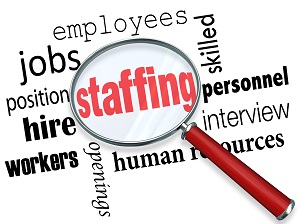OSHA has the resources you need to gain a better understanding of who is responsible for the health and safety of temporary workers.

Temporary workers, who are hired through a staffing agency, have the same rights as permanent workers, including the right to:
- a safe workplace free of dangers.
- receive training in clear language that they understand.
- receive safety equipment.
- speak up about safety.
- report work-related injuries without being punished.
Workers employed through staffing agencies are typically referred to as temporary (or supplied) workers. Temporary workers are provided to a host employer and paid by a staffing agency, whether or not the job is actually temporary.
Whether temporary or permanent, all workers always have the right to a safe and healthy workplace. Host employers must treat temporary workers like any other workers in terms of training and safety and health protections.

The staffing agency and the staffing agency’s client (the host employer) are joint employers of temporary workers and, therefore, both are responsible for providing and maintaining a safe work environment for those workers. The key is communication between the agency and the host to ensure that the necessary protections are provided.
The extent of the obligations of both the agency and the employer will vary depending on workplace conditions and should be outlined in a contract. Safety and health responsibilities will sometimes overlap. Either the staffing agency or the host employer may be better suited to ensure compliance with a particular requirement and may assume primary responsibility for it. The joint employment structure requires effective communication and a common understanding of the division of responsibilities for safety and health and all of this should be in the contract.
There are many best practices recommended by OSHA and NIOSH that can provide guidance to both staffing agencies and host employers.
Staffing agencies do not need to become experts on specific workplace hazards, but should determine what conditions exist at the worksite, what hazards may be encountered, and how to best ensure protection for the temporary workers.

Employers should expect to receive a document that specifies the temporary worker’s specific training and competencies related to the tasks to be performed. Employers can request and review the safety training and certification records of their temporary workers.
The contract should clearly state who is responsible (the agency or the employer) for specific safety and health duties and the employee should understand these responsibilities before their work begins. For example, if the job requires personal protective equipment (PPE), the contract should state what equipment will be needed and if the agency or the employer will supply it.
The scope of the temporary worker’s tasks should also be clearly defined in the agency-employer contract. Having the job description in writing discourages the employer from asking the worker to perform tasks that the worker is not qualified or trained to perform, or which carry a higher risk of injury. Defining, clarifying, and communicating the employers’ and worker’s responsibilities protects the staffing agency, the host employer, and the temporary employee.
If a temporary worker is injured on the job the staffing agency should be informed promptly. Equally, if a staffing agency learns of an injury, they should inform the host employer promptly so that future injuries might be prevented, and the case is recorded appropriately.

Both the agency and the employer should track investigate the cause of workplace injuries but for statistical purposes, OSHA requires that injury and illness records (often called OSHA Injury and Illness Logs) be kept by the organization who is providing day-to-day supervision or controlling the means and manner of the temporary employees’ work, and this is generally the host employer.
OSHA Standard 1904.31(b)(2) If I obtain employees from a temporary help service, employee leasing service, or personnel supply service, do I have to record an injury or illness occurring to one of those employees? You must record these injuries and illnesses if you supervise these employees on a day-to-day basis.
The supervising employer is required to set up a method for employees to report work-related injuries and illnesses promptly and must inform each employee how to report work-related injuries and illnesses. However, both the staffing agency and the host employer should inform the temporary employee on this process and how to report a work-related injury or illness. No policies or programs should be in place that discourage the reporting of injuries, illnesses, or hazards.
OSHA standards require site- and task-specific safety and health training and this training must be in a language the workers understand. The training of temporary workers is a responsibility that is shared between the staffing agency and the host employer. Staffing agencies should provide general safety and health training applicable to different occupational settings, and host employers provide specific training tailored to the particular hazards at their workplaces. Employers should provide temporary workers with safety training that is identical or equivalent to that provided to the permanent employees performing the same or similar work.

For more information on Safety and Health Training for Temporary Workers, please read OSHA’s Temporary Worker Initiative Bulletin No. 4 on Safety and Health Training.
Both staffing agencies and host employers should have a safety and health program in place and ensure that their temporary workers know where to find it, understand it, and participate in it. Employers are also required to have hazard-specific programs when workers are exposed to certain hazards. Such programs include bloodborne pathogens, hearing conservation, hazard communication, respiratory protection, and control of hazardous energy (lockout/tagout).
Employers should expect the staffing agency to check in with their temporary employees to verify that the employer has fulfilled its responsibilities to a safe workplace. The staffing agency should have a written procedure for workers to report any hazards and instances when a worker’s tasks are altered by the host employer from those previously agreed upon.
The staffing agency has a responsibility to follow up on a worker’s safety and health concerns and any complaints with the host employer, as well as investigate any injuries, illnesses, and incidents of close calls.
If your organization employs temporary workers consider reading more about employer responsibilities to protect temporary workers on OSHA’s website at osha.gov/temporaryworkers/. OSHA has released numerous bulletins through their Temporary Worker Initiative Program that each outline specific requirements to consider when hiring temporary workers.


.jpg)
